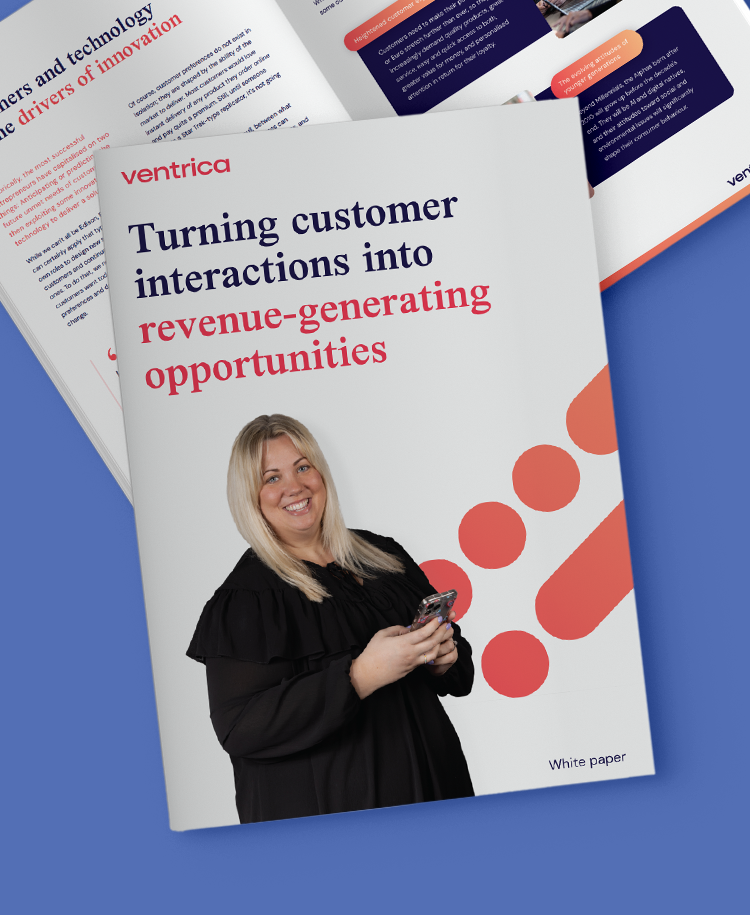The future of CX: Blending AI with the power of human connection
Blending AI with human empathy, Ventrica enhances CX, streamlining processes while maintaining personalised, meaningful customer interactions for lasting loyalty.
- Insights, blogs & articles
Customer expectations have never been higher. Digital transformation has brought speed, convenience, and hyper-personalisation to the forefront of customer experience (CX). Yet, despite the efficiency gains of automation and AI, one thing remains unchanged – people want to feel valued, heard, and understood.
Working across telco, financial services, retail, and e-commerce, I have seen first-hand how brands succeed when they get this balance right. The businesses that stand out are not those that automate everything for the sake of efficiency, nor those that rely solely on human interaction. Instead, the most successful brands use AI to enhance human connection rather than replace it.
At Ventrica, we take a human-first approach to CX, leveraging AI – particularly Zendesk AI – to empower our teams, streamline operations, and create more meaningful customer interactions. The future of CX is not about choosing between automation and empathy. It is about using technology intelligently, ensuring that customers benefit from both speed and sincerity.
AI as an enabler, not a replacement
AI has transformed the way businesses engage with customers. Automated workflows reduce response times, predictive analytics allow businesses to anticipate customer needs, and machine learning enables hyper-personalised interactions at scale. AI-driven tools such as Zendesk AI provide businesses with the ability to manage high volumes of customer interactions without compromising on service quality.
However, while AI can resolve straightforward issues, it lacks the ability to build relationships. Research from the Zendesk 2025 CX Trends Report shows that while AI adoption is driving efficiency, 78% of consumers still prefer some form of human interaction when engaging with brands. Customers do not just seek answers; they want reassurance, understanding, and personalisation beyond what an algorithm can provide.
This is where some brands get it wrong. In the rush to automate, they lose sight of what drives customer loyalty — genuine engagement. AI can create efficiencies, but without the right human touch, customer interactions risk becoming purely transactional.
Industry insights: Why human connection still wins
While AI is transforming CX across industries, its role must be carefully calibrated to complement, rather than override, human engagement. The impact of this balance is particularly evident in telco, financial services, retail, and e-commerce.
In telecommunications, AI-powered voice assistants and chatbots are increasingly used to manage high-volume interactions. However, when customers are dealing with billing disputes, service disruptions, or complex technical issues, automation is insufficient. A well-trained agent, equipped with AI-driven insights, can resolve issues more effectively and with a level of empathy that automation alone cannot replicate.
Financial Services, where trust is paramount, require an even more nuanced approach. AI plays a crucial role in fraud detection and risk management, identifying anomalies faster than any human could. However, when a customer is faced with a security breach or a significant financial decision, reassurance and guidance from a knowledgeable professional remain irreplaceable. A chatbot cannot calm the nerves of a customer who fears they have been defrauded – only a human can do that.
Retail and e-commerce have seen some of the most significant AI-driven advancements in CX, from personalised recommendations to automated returns processing. Yet, customer loyalty in these sectors is not built solely on efficiency. It is the ability to provide real-time support, to handle complex queries with care, and to make the customer feel valued that creates differentiation. AI might suggest the perfect product, but it is the human interaction – whether resolving a complaint or offering personalised advice – that builds long-term brand affinity.
Across all these industries, the same pattern emerges. Customers appreciate the speed and accuracy AI brings, but it is human connection that makes an experience truly memorable.
The Ventrica approach: AI and human empathy working together
At Ventrica, we do not see AI as a substitute for human interaction. Instead, we use Zendesk AI as a co-pilot, equipping our agents with the insights and automation they need to focus on what really matters—building relationships.
This approach delivers three critical advantages.
First, AI enhances efficiency, automating routine tasks such as ticket categorisation and self-service options. This allows human agents to concentrate on higher-value conversations that require judgment and empathy.
Second, AI strengthens customer relationships by providing real-time insights that enable agents to personalise interactions. Rather than following a rigid script, agents can engage customers based on their history, preferences, and sentiment, making every conversation more relevant and meaningful.
Third, AI enables scalability without sacrificing personalisation. Businesses can expand their CX capabilities without losing the warmth and adaptability that customers value. AI may provide data, but it is the human agent who brings context, emotional intelligence, and problem-solving skills to each interaction.
This balance is what separates best-in-class customer service from mere operational efficiency. KPMG UK’s research on “AI colleagues” reinforces this approach, showing that businesses that integrate AI to support rather than replace human employees achieve better customer outcomes while also reducing costs.
What this means for the future of CX
The brands that will lead in CX over the next decade will be those that master this balance — leveraging AI for efficiency while ensuring that human interaction remains at the core of their strategy. According to Zendesk’s 2025 CX Trends Report, UK businesses that have successfully integrated AI and human-led service have already begun to see significant returns, with 90% of early adopters reporting a positive ROI on their AI investments in 2024.
The future of customer experience is not about AI versus humans. It is about creating intelligent, intuitive, and emotionally engaging interactions. Customers will continue to demand fast and seamless service, but their loyalty will be earned through how a brand makes them feel.
Are you ready to elevate your CX?
The most successful brands are those that do not just automate customer interactions but enrich them. If your business is looking to create a scalable, technology-driven, yet deeply human customer experience, Ventrica can help. Through our partnership with Zendesk AI, we enable businesses to build CX strategies that are as efficient as they are empathetic.
To find out how we can help you transform your customer experience, get in touch.

Patrick Lloyd-Bradley
Chief Marketing Officer
